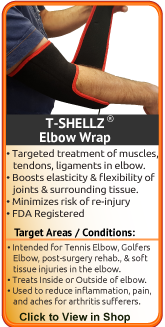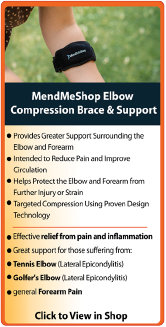|
| How do I Diagnose Tennis Elbow?Medical HistoryPhysical ExaminationYour physician will conduct a physical exam to determine if you are suffering from tennis elbow or a related condition. During your physical exam, your doctor will visually assess your elbow by asking you to extend and flex your elbow, wrist, and fingers. During these exercises, your doctor will place pressure on certain areas of your arm. Your physical exam will help your physician asses your range of motion, muscle and grip strength, joint stability, and pain. Pain or discomfort communicates to your doctor that the muscles, tendons, joints, or tissues may not be healthy. A physical examination of your arm will alert your physician to any physical abnormalities. This could include inflammation, swelling, bone deformity, or atrophied muscle.  Typically, your medical history and physical exam will give your physician enough information to make a diagnosis. If your doctor believes that your symptoms are due to something other than Tennis Elbow, further testing will need to be done to determine the correct diagnosis. It is rare that more complex diagnostic techniques will be used to diagnose Tennis Elbow, but they can be effective in helping determine the cause of your symptoms. An X-Ray, which uses short electromagnetic radiation waves to create an image, can help your doctor get a detailed picture of your bone structure. This can help determine if a fracture or arthritis are the cause of your symptoms. Your body is a complex system; everything is interconnected. Because of this, problems in your neck, shoulder, or arm could cause symptoms similar to Tennis Elbow. An MRI or Magnetic Resonance Imaging sends out a strong magnetic field and radio waves over your body. This creates an image of your bones and soft tissues. An MRI can help doctors see if there is an issue in another part of your body. An EMG or Electromyography test uses small wires placed in your muscles to detect any changes in nerve signals during movement. When assessing your elbow, this test is helpful in determining if your symptoms are being caused by a pinched nerve. Your physician will check for inflammatory conditions such as bursitis, which affects liquid filled capsules in the joint or osteochondritis which affects the cartilage or bone of a joint. Struggling To Rid Yourself of Tennis Elbow?The good news is that most cases of tennis elbow will heal with simple home conservative treatments and surgery is often not needed! It's generally understood by doctors and surgeons, that surgery will introduce more scar tissue into the elbow. This added scar tissue will be problematic, requiring visits to the Physio clinic and conservative treatment options post-surgery. This is why surgery is only performed as a last resort for chronic elbow injuries or a fractured bone that won't heal with conservative treatment methods. To look into conservative treatment options for soft tissue injuries in the elbow and forearm, please go to our tennis elbow treatments page. Product Advisors are available 9:00 am to 5:00 pm Eastern Standard Time Monday to Friday. Learn More About Elbow Injuries & TreatmentsI want to learn more about TShellz Wrap® Circulatory Boost I want to learn more about Ice & Heat: Which Is Better For Treatment? I want to learn How To Get Rid of Tennis Elbow I want to learn How To Get Rid of Golfers Elbow I want to learn more about Elbow Anatomy I want to learn more about Elbow Surgery I want to learn more about Elbow Post-Surgery Recovery During your recovery, you will probably have to modify and/or eliminate any activities that cause pain or discomfort at the location of your soft tissue injury until the pain and inflammation settle. Always consult your doctor and/or Physical Therapist before using any of our outstanding products, to make sure they are right for you and your condition. The more diligent you are with your treatment and rehabilitation, the faster you will see successful results! |
    |
